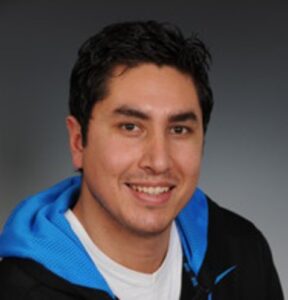Interplay of active nematic defects and flow structures
Active nematics are a class of liquid crystals driven out-of-equilibrium by the intrinsic activity of the rod-like constituents. In bulk, global nematic order is destabilised via the coupled feedback between nematic deformations and active flows, facilitating a steady-state population of pairs of half-integer nematic topological defects and chaotic flows (active turbulence). When confined, active nematics can exhibit active turbulence if the activity is sufficient, or more ordered spatiotemporal flow field patterns with a reduced defect count, dependent on the confinement scale. Understanding these complex flow regimes have naturally favoured perspectives centred on the nematic defects, as their emergent steady-state presence is an evident feature of active nematics. Defect orientation, motility and flow generation has been employed to study quasi-particle like descriptions of larger scale flow structures [1]. Within this description, the production of active flows around defects has been studied [2], revealing that the flow-field solution around a +1/2 defect is associated with two vortices and a self-propulsion velocity, while the -1/2 defect is associated with six vortices and active flows tending to zero at their core. However, this viewpoint is necessarily an oversimplification since flows are not simply governed by defects – flows influence the defects in parallel. The reverse viewpoint, ‘how nematic defects respond to the structure of the flow field’, is therefore important for understanding the architecture of active flow patterns but has not received adequate attention. Through experiments of microtubule-kinesin based active nematics [3], and mesoscopic simulations [4], we explore how defects couple to the structure of the velocity field in 2D. We adopt a topological description of the velocity field, identifying the borders between rotationally dominated and strain-rate dominated regions. We establish the importance of these boundaries as paths for defect dynamics and categorize defect behaviours into two regimes associated with +1/2 defects tracing either one boundary or instantaneously traversing intersections. These results demonstrate that the ideal picture of two vortices associated with each of the +1/2 defects is not characteristic of active nematics. Through utilizing topological descriptions of structures in the director field and velocity field, we can provide a complementary perspective on active nematic flows and possible control mechanisms by manipulating either field.
References:
[1] S. Shankar and M. C. Marchetti, Phys Rev. X 9, 041047, (2019)
[2] L. Giomi et al., Phil. Trans. R. Soc. A. 372:20130365, (2014)
[3] J. Hardoüin et al. Nat. Commun. 13 (1), 6675, (2022)
[4] K. Thijssen et al. Soft Matter 16, 2065-2074, (2020)

